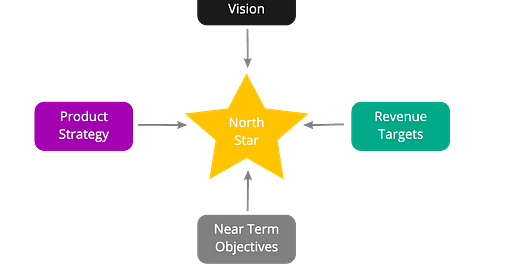For any startup or product launch, everything starts with your vision. “A computer on every desk” or “Increase the GDP of the internet” or “Accelerate the world’s transition to sustainable energy.” This is evergreen, and applies throughout your company’s lifetime.
Next you build product and go-to-market strategy. How will we achieve our vision, why will we win, what problem will we solve for our customers? This is durable, lasting you for a 3-5 year timeframe.
Then set your goals; these are shorter, more actionable, and can translate to your roadmap and tactics. Typically you set annual and quarterly goals or OKRs.
So how do you bring all of that - vision, strategy, tactics - into alignment? Defining a North Star metric is a great step. It helps you define your success in terms of customer outcomes, puts both success criteria and constraint on every project, and brings your team onto the same page about “why” with every key decision.
The North Star metric is a simple description of your progress, and stands on its own as a measurable unit of the value you’re creating from your customer.
The North Star metric aligns product development and go-to-market operations with a shared definition of customer value.
If you do it right, a North Star metric will simplify goal-setting, de-centralize effective decision making, and help you easily track and message your progress to internal and external stakeholders.
First Principles of a North Star Metric
What it’s NOT:
An input metric (like product delivery). A good North Star metric measures output, leverage your product creates for your customer
A vanity metric (like social shares) that do not connect directly to customer or business value
A KPI that measures value to the business (like revenue). A good North Star metric measures value from the customer perspective, not the company
The only metric you’ll ever need. North Star is a framework for goal-setting and decision making. It’s not a KPI, it doesn’t work as a stand-alone goal, and it doesn’t replace business performance dashboards
A way to measure your team’s performance. North Star metrics are holistic measures of the company (product + team) as a whole; we can’t assign movement in a North Star metric to individuals or use it to define performance
A concept that will live forever. The North Star is most useful after product/market fit (where you won’t be ready to set it), but before your company is truly scaling (where the complexity of goal-setting and operations makes aligning on a single metric impractical)
What it IS:
a unifying concept to help you drive more effective cross-functional goalsetting
a direct expression of customer value
a measure of the leverage your product creates for your customer
easily defined and understood by anyone inside or outside the company
accessible to calculate and track regularly
In selecting a good North Star, start with your input metrics, the direct levers you use as KPIs to measure progress. For SaaS companies for example, these are $ ARR, % net retention, # users, and production adoption metrics. You need to define those first, before you’re ready to choose one metric where movement in your outcome metric (North Star) will drive your input metrics (i.e. if it moves, you’ll see benefits in revenue, user growth, and customer health).
Ask your teams, what are the most important outcomes they’re seeking to drive?Summarize, consolidate, narrow down; you’ll have a list to score, vote or otherwise create some signal. Look to find balance across all your functions and connect your growth to customer value.
Case Studies
Here are some examples of solid North Star metrics:
There are a few themes here, related to business model (advertising, freemium or subscription, transactions based) or vertical (B2B vs B2C)
B2C companies focus on either activating users or driving more engagement per user; their revenue flows from aggregating lots of individual engagement events and then monetize via subscription, advertising, or taking a % of the transaction. Among B2C companies there’s a diversity of North Star metrics across activation (like Plaid or Instacart), growing transactions from active users within the marketplace (like Amazon, Uber, or Airbnb), and engagement of users with the app (like Facebook or Spotify).
Meanwhile B2B companies are more likely to focus on key conversion events that demonstrate success across the customer lifecycle. Many of these companies have a freemium model paired with pricing plans, where tiers of access or features are gated encouraging a user to pay to accomplish a specific job to be done. These companies try to align their North Star with the core value of the product, with varying levels of success. Dropbox and Slack look for an indicator of likelihood to upgrade (documents shared, teammates I collaborate with) while Airtable and Jira seek to measure through active paid users. And as to be expected as we take a look at startup stage businesses we see more creativity in the North Star as well as more refinement to the specific customer value of a product (this is a good thing!) For example Miro focused on the number of boards users create and share, Loom focuses on engagement with the product a user creates (and not the creation itself), and Amplitude gets to the heart of their value proposition with a custom metric called Weekly Learning Users (WLUs).
To make it on this list, a company’s North Star metric has implicitly passed the test of success (for the most part we are looking at category-defining winners). So the diversity here is notable. There’s no shortcut here; you’ll have to be thoughtful and specific to find your North Star as it’s bespoke to your business.







